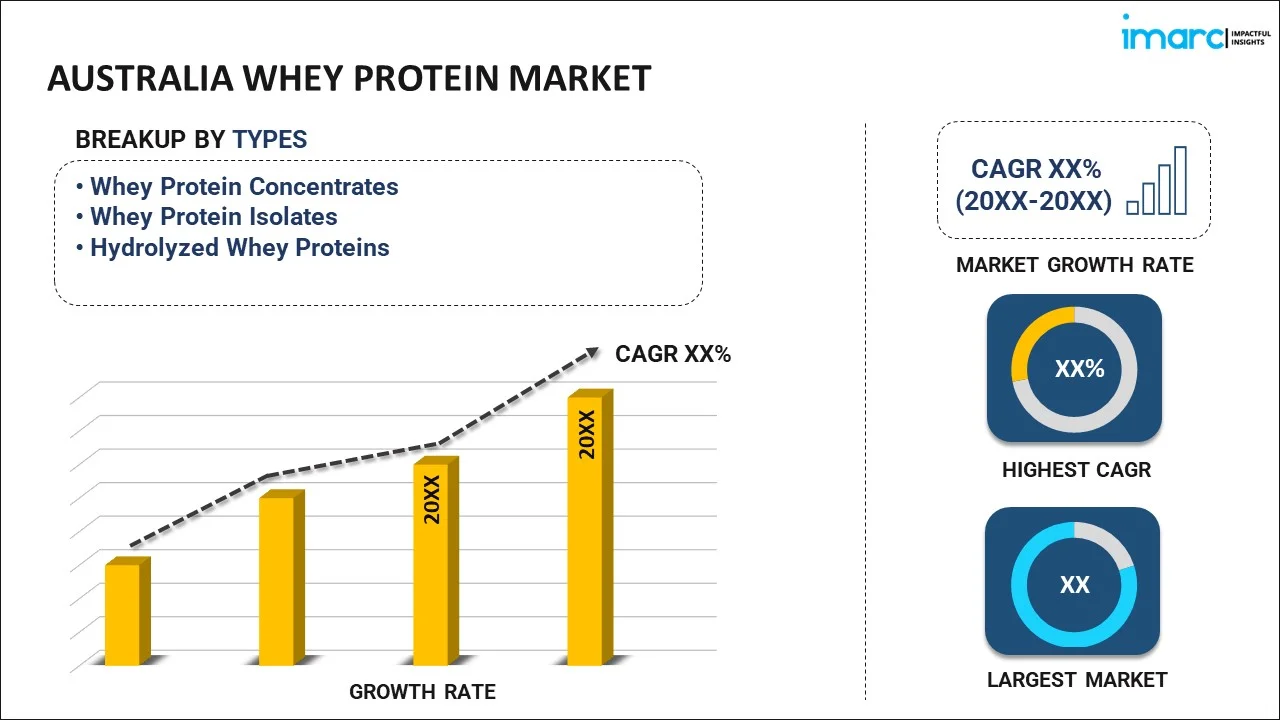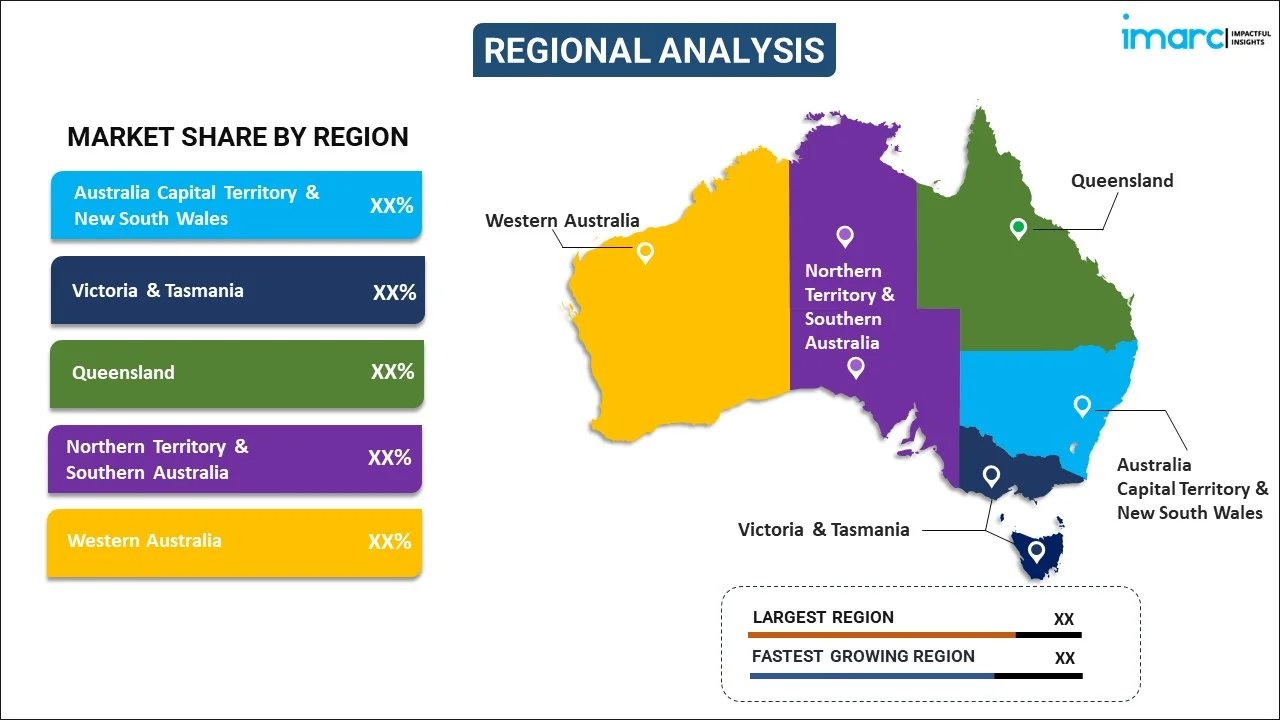
Australia Whey Protein Market Report by Type (Whey Protein Concentrates, Whey Protein Isolates, Hydrolyzed Whey Proteins), Application (Sports and Performance Nutrition, Infant Formula, Functional/Fortified Food), and Region 2025-2033
Market Overview:
Australia whey protein market size reached USD 110.0 Million in 2024. Looking forward, IMARC Group expects the market to reach USD 166.4 Million by 2033, exhibiting a growth rate (CAGR) of 4.70% during 2025-2033. The escalating demand for sports nutrition products among athletes who are looking to optimize their performance is primarily driving the market growth across the country.
|
Report Attribute
|
Key Statistics
|
|---|---|
|
Base Year
|
2024
|
|
Forecast Years
|
2025-2033
|
|
Historical Years
|
2019-2024
|
|
Market Size in 2024
|
USD 110.0 Million |
|
Market Forecast in 2033
|
USD 166.4 Million |
| Market Growth Rate 2025-2033 | 4.70% |
Whey protein, an excellent protein source, is extracted from milk as a byproduct of the cheese-making process. It originates from the liquid remaining after milk curdles and undergoes straining. Through multiple processing stages, this liquid is separated and transformed into a powdered form extensively employed as a dietary supplement. Whey protein is recognized as a comprehensive protein, encompassing all essential amino acids crucial for bodily functions. These amino acids, vital for processes like muscle growth, repair, and maintenance, serve as the fundamental building blocks of protein. Whey protein's nutritional completeness and its role in supporting various physiological functions make it a widely sought-after dietary addition.
Australia Whey Protein Market Trends:
The Australia whey protein market is experiencing significant growth, driven by the elevating awareness among individuals towards fitness and nutrition, which in turn, is compelling them to seek high-quality supplements. This is propelling the demand for whey protein, which is recognized for its complete amino acid profile and effectiveness in muscle development and recovery. Furthermore, the growing emphasis on sustainable and clean-label products is reshaping consumer preferences in the country. Besides this, the Australia whey protein market is augmenting, owing to the emerging trend of using whey protein products that are ethically sourced, minimally processed, and environmentally friendly. As such, consumers are increasingly seeking transparency in the supply chain and a commitment to eco-friendly practices. Moreover, innovation in product formulations is another pivotal trend, with manufacturers introducing flavored variants and convenient packaging. This strategic evolution aligns with consumer desires for diverse flavor options and on-the-go nutritional solutions. Additionally, the elevating integration of e-commerce platforms and strategic collaborations with fitness influencers are enhancing market accessibility and visibility in Australia. This digital-savvy approach caters to the evolving preferences of consumers, which is expected to bolster the whey protein market across the country over the forecasted period.
Australia Whey Protein Market Segmentation:
IMARC Group provides an analysis of the key trends in each segment of the market, along with forecasts at the country level for 2025-2033. Our report has categorized the market based on type and application.
Type Insights:

- Whey Protein Concentrates
- Whey Protein Isolates
- Hydrolyzed Whey Proteins
The report has provided a detailed breakup and analysis of the market based on the type. This includes whey protein concentrates, whey protein isolates, and hydrolyzed whey proteins.
Application Insights:
- Sports and Performance Nutrition
- Infant Formula
- Functional/Fortified Food
A detailed breakup and analysis of the market based on the application have also been provided in the report. This includes sports and performance nutrition, infant formula, and functional/fortified food.
Regional Insights:

- Australia Capital Territory & New South Wales
- Victoria & Tasmania
- Queensland
- Northern Territory & Southern Australia
- Western Australia
The report has also provided a comprehensive analysis of all the major regional markets, which include Australia Capital Territory & New South Wales, Victoria & Tasmania, Queensland, Northern Territory & Southern Australia, and Western Australia.
Competitive Landscape:
The market research report has also provided a comprehensive analysis of the competitive landscape in the market. Competitive analysis such as market structure, key player positioning, top winning strategies, competitive dashboard, and company evaluation quadrant has been covered in the report. Also, detailed profiles of all major companies have been provided.
Australia Whey Protein Market Report Coverage:
| Report Features | Details |
|---|---|
| Base Year of the Analysis | 2024 |
| Historical Period | 2019-2024 |
| Forecast Period | 2025-2033 |
| Units | Million USD |
| Scope of the Report | Exploration of Historical Trends and Market Outlook, Industry Catalysts and Challenges, Segment-Wise Historical and Future Market Assessment:
|
| Types Covered | Whey Protein Concentrates, Whey Protein Isolates, Hydrolyzed Whey Proteins |
| Applications Covered | Sports and Performance Nutrition, Infant Formula, Functional/Fortified Food |
| Regions Covered | Australia Capital Territory & New South Wales, Victoria & Tasmania, Queensland, Northern Territory & Southern Australia, Western Australia |
| Customization Scope | 10% Free Customization |
| Post-Sale Analyst Support | 10-12 Weeks |
| Delivery Format | PDF and Excel through Email (We can also provide the editable version of the report in PPT/Word format on special request) |
Key Questions Answered in This Report:
- How has the Australia whey protein market performed so far and how will it perform in the coming years?
- What has been the impact of COVID-19 on the Australia whey protein market?
- What is the breakup of the Australia whey protein market on the basis of type?
- What is the breakup of the Australia whey protein market on the basis of application?
- What are the various stages in the value chain of the Australia whey protein market?
- What are the key driving factors and challenges in the Australia whey protein?
- What is the structure of the Australia whey protein market and who are the key players?
- What is the degree of competition in the Australia whey protein market?
Key Benefits for Stakeholders:
- IMARC’s industry report offers a comprehensive quantitative analysis of various market segments, historical and current market trends, market forecasts, and dynamics of the Australia whey protein market from 2019-2033.
- The research report provides the latest information on the market drivers, challenges, and opportunities in the Australia whey protein market.
- Porter's five forces analysis assist stakeholders in assessing the impact of new entrants, competitive rivalry, supplier power, buyer power, and the threat of substitution. It helps stakeholders to analyze the level of competition within the Australia whey protein industry and its attractiveness.
- Competitive landscape allows stakeholders to understand their competitive environment and provides an insight into the current positions of key players in the market.
Need more help?
- Speak to our experienced analysts for insights on the current market scenarios.
- Include additional segments and countries to customize the report as per your requirement.
- Gain an unparalleled competitive advantage in your domain by understanding how to utilize the report and positively impacting your operations and revenue.
- For further assistance, please connect with our analysts.
 Inquire Before Buying
Inquire Before Buying
 Speak to an Analyst
Speak to an Analyst
 Request Brochure
Request Brochure
 Request Customization
Request Customization




.webp)




.webp)












